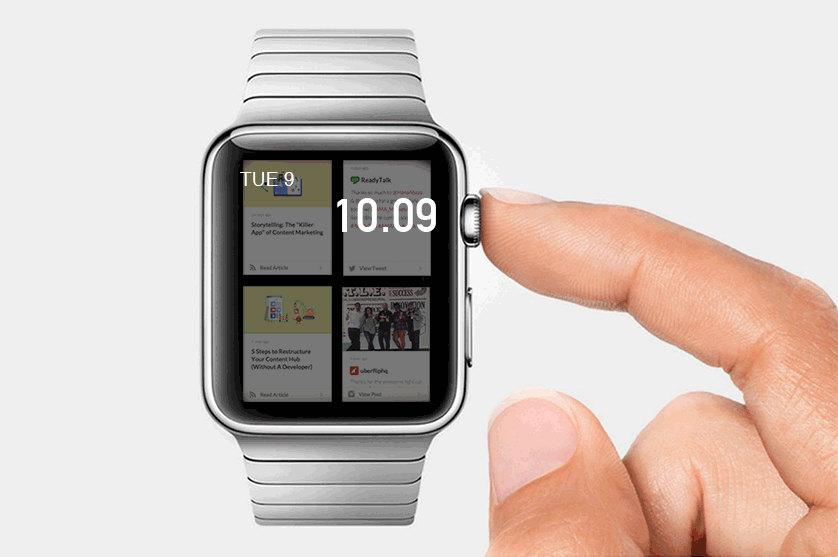There’s no denying the wearable device trend. The wearable device market is on track to reach a value of $12.6 billion by 2018, with a projected 111.9 million units being shipped within the next two years.
As more individuals adopt wearable devices, it’s worth examining this growing user base, and taking into considerations the benefits that a wearable app might offer your organization. However, there are a few important questions to ask and considerations to make with the development of this kind of application:
1) First things first: Why develop a wearable app?
The first query to examine here is the main reason behind the organization’s choice to develop an app. It’s imperative to keep in mind that wearable applications are a different breed – the app created for a wearable device will not be the same as one developed for a smartphone or tablet.
Wearable apps come with certain limitations, including screen size and feature capabilities. In this way, wearable apps are typically built upon the abilities and experience offered by an original app developed for the mobile platform. Overall, the wearable app should expand and improve upon the original experience, while still offering something new and exciting for the user.
2) Wearable UX: What experience can the wearable app offer?
As noted, the UX of a wearable app will be considerably different than that offered by a program designed for a smartphone or tablet. A wearable device can be leveraged to expand upon the capabilities of the original app, enabling the user to access specific features or sections of the app from their wearable without having to take his mobile device out of his pocket.
Because wearable devices are so new, designers and developers are still working to establish best practices and trends for the user experience. However, a few main points have come to light within the wearable development sector:
- Feature limitations: Currently, wearable devices offer a limited scope when it comes to their feature capabilities. As noted, wearable apps do not provide the same level of usability as an original mobile app would. For this reason, developers should stick to a small set of core features when designing the wearable UX.
- Faster access: However, what wearables lack in features, they make up for in speed a main selling point of wearable devices is the fact that these units can make interacting with certain parts of an app faster and easier than utilizing a mobile phone or tablet.
- Simplified design: When establishing the wearable app user experience, it’s important to keep things simple. A UX that is too detail-oriented or complex can distract from the purpose and functionality of the app. For this reason, it’s best to maintain a limited focus and leverage a streamlined design. Less is more ;)
- User centric: It’s critical that the UX being created is considerably user centric. Designers and developers should keep the user in mind throughout the process, and ensure that the app provides an experience that will be valuable in daily life.

Image source: uberflip.com
3) What uses are the potential use cases?
When contemplating a wearable app, it can be helpful to examine the possible use cases for the device and program. For instance, wearable devices have been popular within the healthcare and fitness industries. However, additional use cases are emerging, including in the industrial sectors, where wearable apps can provide a hands-free experience for workers. Other areas, such as the financial sector, could also benefit from a wearable app to provide instant access to important information.
Before developing the wearable app, the team should take the time to consider how it can be utilized best. This line of thinking can help ensure that a specific set of users is targeted, and that this audience is prime focus for the team throughout the development process.
4) Remember: It’s a new and changing landscape
Finally, it’s essential to keep in mind that for many businesses and development teams, wearable apps are new territory. The wearable app sector is considerably new, and aspects including best practices, use cases, design as well as user trends are emerging and changing all the time. This is particularly true as new wearable devices with unique feature capabilities come to market.
While this quickly changing industry can present certain challenges, it does come with considerable opportunities. Wearable app developers can use this landscape to their advantage, and experiment with innovative and imaginative strategies for their application.
As a gaming enthusiast, I can’t avoid mentioning the Lifeline case. This gaming app has become one of the most popular iOS games over the last months since it increased recognition after being launched for Apple Watch. What I mean is that there’re lots of ideas and new markets to discover and develop. The important thing here is to analyze what kind of added value can your app provide in order to have the Wow factor and reach to the top charts of the app stores.
Want to read more about Wearables? Take a look at this useful links:
- The Internet of Me: How Wearable Tech is Changing IoT: http://www.dataart.com/downloads/ADA-IoT-Wearables-Final.pdf
- How to Avoid Costly Mistakes in Developing Wearable Apps: http://www.wired.com/insights/2014/05/avoid-costly-mistakes-developing-wearable-apps/
- The Who, What, When, Wear, and Why of Wearable Technology: http://uxmag.com/articles/the-who-what-when-wear-and-why-of-wearable-technology
- Designing A User Experience For Wearable Devices: http://usabilitygeek.com/wearable-devices-user-experience/
